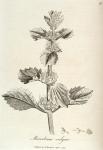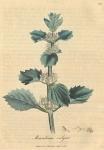
 Synonyma. Marrubium. Pharm. Lond. & Edinb.
Synonyma. Marrubium. Pharm. Lond. & Edinb.
Marrubium album vulgare. Bauh. Pin. p. 230. Park. Theat. p. 44.
Marrubium album. Gerard Emac. p. 693. Raii Hist. p. 556. Synop. p. 239.
Marrubium dentibus calycinis denis, recurvis. Hal. Stirp. Helv. n. 258. Hudson. Flor. Ang. p. 260. Withering. Bot. Arrang. p. 617.
Class Didynamia. Ord. Gymnospermia. Lin. Gen. Plant. 721.
Ess. Gen. Ch. Cal. hypocateriformis, rigidus 10-striatus. Corollae lab. sup. 2-fidum, lineare, rectum.
Spec. Char. M. dentibus calycinis setaceis uncinatis.
The root is perennial, and furnished with numerous fibres: the stalks are upright, strong, square, hairy, or downy, and rise about a foot and a half in height: the leaves are roundish or oblong, deeply serrated, veined, wrinkled, hoary, and stand in pairs upon thick broad footstalks: the flowers are white, and produced in whorls at the footstalks of the leaves: the calyx is tubular, scored, and divided at the mouth into ten narrow segments, which are hooked at the end: the corolla is monopetalous, gaping, compressed, consisting of a cylindrical tube, opening at the mouth into two lips: the upper lip is narrow, and cloven or notched; the under lip is broader, reflected, and divided into three segments, the middlemost of which is broad, and slightly scolloped at the end; the lateral segments are spear-shaped and short: the filaments are two long and two short, supplied with simple anthers, which are concealed in the tube: the germen is divided into four parts, from which issues a slender style, furnished with a cloven stigma: the seeds are four, of an oblong shape. It grows near the sides of roads and rubbish, and flowers in June.
"The leaves of Horehound have a moderately strong smell of the aromatic kind, but not agreeable, which by drying is improved, and in keeping for some months is in great part dissipated: their taste is very bitter, penetrating, diffusive, and durable in the mouth." "The dry herb gives out its virtue both to watery and spirituous menstrua: on inspissating the watery infusion, the smell of the Horehound wholly exhales, and the remaining extract proves a strong and almost flavourless bitter: rectified spirit carries off likewise greater!: part of the flavour of the herb, leaving an extract in less quantity than that obtained by water, and of more penetrating bitterness." [Lewis, M. M. p. 411.]
This plant is the (greek) of the ancients, by whom it is greatly extolled for its efficacy in removing obstructions of the lungs and other viscera. [Dioscorides, Lib. iii. c. 119. See also Pliny, Lib. xx. c. 22.] It has chiefly been employed in humoural asthmas, [Rhazes ad Mansor. 3. n. 42. Particularly, infarctions of the lungs and difficulty of breathing from viscid mucous. Lösecke, Arzneym. p. 382. Lange, Miscell. verit. med. p. 57.] obstinate coughs, and pulmonary consumptions; [Alex. Trallian. Lib. v. Vide Celsus, Lib. iii. cap. 22. Caelius Aurelianus, Morb. chron. Lib. ii. p. 423. De Haen Rat. Medend. P. iv. p. 252. But he and Haller often found it fail; the latter says, Ego quidem in morbis similibus cum difficili sputorum excreatione infusum aquosum utiliter dedi: & in phthisi satis profecla semel vidi utile fuisse, non autem in aliis exemplis: potius vero mihi movere videtur, quam reprimere. l. c.] instances are also mentioned of its successful use in scirrhous affections of the liver, [Zacutus Lusitanus, Prax. admir. Lib. 2. Obs. 48. Chomel, Usuell. T. i. p. 232.] jaundice, [Forrest. Op. Lib. 19. Obs. 19. & 40.] cachexies, and menstrual suppressions. [ Borellus, Hist. et Observ. Cent. iv. p. 14.]
That Horehound possesses some share of medicinal power may be inferred from its sensible qualities, [Taken in considerable quantities it is said to loosen the body.] but its virtues do not appear to be clearly ascertained, [Bergius says, Virtus: tonica, emmenagoga, diuretica. Usus: Cachexia, ob. mensium, Hysteria, Asthma pituitosum.] and the character it formerly obtained is so far depreciated, that it is now rarely prescribed by physicians. A dram of the dry leaves in powder, or two or three ounces of the expressed juice, or an infusion of half a handful of the fresh leaves have been directed for a dose. This last mode is usually practised by the common people, with whom it is still a favourite remedy in coughs and asthmas. ["It has had the reputation of a pectoral: but in many trials, its virtues in that way have not been observed; and in several cases it has been judged hurtful. For its use in Asthma and Phthisis, and for its power in resolving indurations of the liver, I consider the authorities of Forrestus, Zacutus Lusitanus, and Chomel, to be very insufficient; and the events they have ascribed to it seem to be very improbable." Cullen Mat. Med. vol. ii. p. 155.]

